
A Hunger for Life, A Passion for Words
Deep dives into the mythic life of Sir Walter Raleigh
By D.G. Martin
East Carolina University professor and distinguished public historian Larry Tise recently argued that Sir Walter Raleigh’s attempted settlement on the North Carolina coast was an “egregious error” that we have spun “into the romanticized saga of a ‘lost colony.’”
Tise is an expert about Sir Walter, but there is more to the story, as retold in two new books: The Secret Token: Myth, Obsession, and the Search for the Lost Colony of Roanoke, by Andrew Lawler, and Anna Beer’s Patriot or Traitor: The Life and Death of Sir Walter Raleigh.
Although Lawler acknowledges Raleigh’s errors and weaknesses as outlined by Tise, he sets out in great detail the magnitude of his efforts to establish an English colony on the North Carolina coast. “The Roanoke venture lasted for six years and involved two dozen vessels and well over a thousand people crossing the treacherous breadth of the Atlantic to establish England’s first beachhead in the New World. In size, scope, and cost, it far outstripped the later inaugural voyages to Jamestown and Plymouth. It was the Elizabethan equivalent of the Apollo program.”
On March 16, 1584, Queen Elizabeth granted Raleigh the right to colonize the East Coast of North America south of Newfoundland. The next month Sir Walter had two ships on their way conducting an exploratory mission. The ships arrived on the North Carolina coast in July.
After six weeks of scouting and making friends with the native population, the expedition had not found gold mines or a short cut to China. However, it came back with tales of the good life, samples of tobacco and pharmaceuticals, and two natives, Wanchese and Manteo.
Raleigh then organized a much larger effort. On April 9, 1585, five vessels carrying between 400 and 800 men left England. Manteo and Wanchese were on board. So were soldiers and scientists, including a brilliant scholar and linguist, Thomas Harriot; a metallurgist, Joachim Gans; and a draftsman and artist, John White. By June 26 the colonizers arrived and began the process of exploring the nearby sounds and adjoining lands. The results were mixed. While they gained good and valuable information, the expedition ran low on supplies and all but about 100 men returned to England in September.
The remaining men suffered through the winter. Food was scarce, and the formerly friendly natives had become hostile enemies. When a fleet of English ships under the command of Sir Frances Drake appeared in early June 1586, the settlers abandoned the project and returned with Drake to England. The disappointing result did not deter Raleigh from organizing a third effort in 1587 — a group of men, women and families that became North Carolina’s legendary Lost Colony.
In July 1587, the colonists arrived on Roanoke Island led by their governor, John White, whose granddaughter, Virginia Dare, was born on August 18. A few days later, White sailed to England for much-needed supplies. When he finally returned in August 1590, the colony had disappeared, leaving only a carving of “Croatoan” on a tree as a clue.
The mystery of what happened to Virginia Dare, her family and their fellow colonists is the stuff of legend. One fable says Dare grew to be a lovely young woman and was transformed into a white doe, an animal that still haunts coastal North Carolina. A somewhat less fantastical theory maintains she and other colonists made their way to Robeson County, where locals will show you her purported burial site near Red Springs. Other authors suggest the colonists, including Dare, died from hunger, disease, or were killed by Native Americans. Or perhaps, in order to survive, they joined nearby Native Americans and were absorbed by them.
In The Secret Token, Lawler gives a history of the developing interest in Virginia Dare and the Lost Colony. After her baptism certificate in 1587, there was no public mention of her until 1834. In that year, Harvard-trained historian George Bancroft published his influential A History of the United States. Lawler writes, “It is difficult to overstate his impact on the way we see Raleigh’s colony today.”
For Bancroft, the colony was “the germinating seed” for our country and its institutions, “just as important as its revolutionary coming of age.” Lawler writes that in Bancroft’s view, “Roanoke was, in essence, the nation’s humble Bethlehem, and Dare was its infant savior destined for sacrifice.”
Lawler chronicles efforts to learn where the colonists, if they survived, went. To Croatoan, now a part of Hatteras Island? To Site X, a place marked under a patch in a map drawn by John White, located where the Roanoke River flows into the Albemarle Sound? Or to the Chesapeake Bay, near where the Jamestown Colony settled, and where Powhatan, the local Indian king, massacred them?
Maybe it was near Edenton, where in 1937, a California man said he found a large stone inscribed with a message from Dare’s mother, Eleanor, to her father, John White, reporting the death of her husband, her daughter Virginia, and other colonists. Lawler’s account of this likely scam is almost as interesting as the story of the colonists told by Harnett County native and Pulitzer Prize winner Paul Green’s outdoor drama, The Lost Colony.
In Patriot or Traitor Anna Beer devotes only a few pages to Raleigh’s colony on Roanoke Island, saving space for other and more significant parts of his life in chapters titled as follows:
“Soldier” — In 1569, as a teenager, he fought with the Huguenot Protestants in France and later in Ireland.
“Courtier” — By 1581, he had gained a position in the queen’s court.
“Coloniser” — As a favorite of the queen, he was given authority to establish settlements on the North American coast.
“Sailor” — No great sailor himself, he was nevertheless responsible for important naval actions and victories over Spanish naval forces.
“Lover” — Beer writes, “Sir Walter and his Queen were lovers, but it is highly unlikely that their ‘love’ was ever physically expressed. It was an eroticized political relationship, not a political sexual relationship, and Elizabeth was on top.”
“Explorer” — Although he never set foot on Roanoke Island, he personally led two ambitious, risky, and ultimately unsuccessful explorations to Guiana in today’s Venezuela in search of gold.
“Writer” — Beer heaps praise on his prose, “His writing stands shoulder-to-shoulder with that most remarkably rich and enduring of contemporary works, the 1611 King James Bible.”
Beer begins Raleigh’s story, not with these looks into his extraordinary early life, but in 1603. In that first year of the reign of King James I, Sir Walter was found guilty of treason for allegedly plotting against the new king. His sentence, quoted on the first page of Beer’s book, is a horrifying reminder of the gruesome justice of those times:
“You shall be drawn upon a hurdle through the open streets to the place of execution, there to be hanged and cut down alive, and your body shall be opened, your heart and bowels plucked out, and your privy members cut off, and thrown into the fire before your eyes . . . ”
How Sir Walter was able to defer his execution for almost 15 years and use the time to continue active participation in public life is the material for Beer’s final chapters. In conclusion she writes that Raleigh “lived more lives than most people of his time, or of any time” and that he “had a hunger for life, a longing for death, a despair for truth and a passion for words.” OH
D.G. Martin hosts North Carolina Bookwatch, airing on UNC-TV Sunday at 11 a.m. and Tuesday at 5 p.m. The program also appears on the North Carolina Channel, a digital channel carried by many cable systems.





